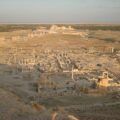Metamorphosis of a Dream

Sharif Ahmedov is one of many translators of the great Jorge Luis Borges. But as far as I know, he is Borges’ only translator into Uzbek. His collection of Borges in Uzbek was released only recently, joining his translations of Julio Cortázar, Khalil Gibran, and other 20th-century classics on the shelves of Tashkent’s bookstores. Translating such renowned authors into such a little-known language and culture is a feat of intellect and imagination that inevitably leaves its mark on the translator. Ahmedov responded by writing a whole book about that feat: his collection of stories and essays Bir tushning evrilishlari (Metamorphoses of a Dream), inspired by his work transforming Borges’s stories of transformation.
When Ahmedov approached me about translating those essays into English, I was captivated by the idea—and then, as I read, by his prose. Just as alluring, for me, was the complexity of the task at hand: to translate the title essay, “Metamorphosis of a Dream,” I was being asked to create an English translation (my own) of an Uzbek essay (Ahmedov’s) about a Spanish story (Borges’) pondering an English poem (Coleridge’s) about a perhaps imaginary palace built by a Mongol emperor (Kublai Khan).
Ahmedov’s essay starts with the nature of dreams and inspiration, his response to Borges, but along the way it veers in a surprising direction—from Kublai Khan’s palace to the Taj Mahal, from Coleridge’s dream to Bobur’s empire. This essay simply delights in exploring the interconnections between geniuses in different times and places, and the cultural disconnects between centuries and cultures, and how all those elements may or may not work together in the world of art and high beauty.
Think of this essay as a journey through uncharted territory where vaguely familiar literary traditions meet, becoming quite unfamiliar in the process. I hope you enjoy the trip.
Shelley Fairweather-Vega, translator
In his story “Coleridge’s Dream,” Jorge Luis Borges tells us of something that happened to the famous English romantic poet Samuel Taylor Coleridge (1772–1834). One time, after his ill health prompts him to take a narcotic sleeping aid, Coleridge picks up a work by Purchas which describes the deeds of a Mongol ruler. After a while, sleep finally overcomes our poet, and he dreams vividly, a lyrical fragment of unusual beauty, singing the praises of the paradisaical majesty of a palace planned and built out of the daydreams of the Mongolian lord. Upon waking, he hurries to begin writing down those mystical lines, fearing that fragments will be lost to the reliably approaching reality of the daytime world. But, as it always happens, an unexpected visitor interrupted his work. “To my no small surprise and mortification,” Coleridge wrote, according to Borges, “though I still retained dimly a vague recollection of the vision, all the rest, with the exception of some eight or ten scattered lines, had passed away like the rings on the surface of a stream with a stone cast into it, but, alas! their restoration was no longer possible.” Nevertheless, the poet’s notable contemporaries evaluated very highly even these fragments of the unfinished poem.
Then the storyteller leads us away on an excursion and introduces us to more or less similar cases experienced by other historical personages. We learn of the supernatural influence of dreams on the composer Giuseppe Tartini (his “Trillo del Diavolo” sonata), and on Robert Louis Stevenson (Olalla and Jekyll and Hyde). Once awake, Tartini tried to reproduce the music of his dream; Stevenson received the plots in his dreams, just their general outlines. Also notable is the case associated with Caedmon, the “first sacred poet of the English nation.” No longer young, formerly a simple shepherd, Caedmon once lay down to sleep in a stable, among the horses, and in his dream, somebody summoned him by name and ordered him to sing. Caedmon answered that he didn’t know how, but he was told, “Sing of the beginning of all creation.” Immediately Caedmon began to sing verses that he had never heard before. When he awoke, he still remembered them, and he was able to repeat them for the monks in the nearby monastery. He never had learned to read, but the monks explained to him the texts of sacred tales, and “he chewed them over like a good animal chewing its cud and converted them into delightful verses, praising the creation of the world and man and the whole story told in Genesis, and the Exodus of the children of Israel and their entrance into the Promised Land, and much else from Scripture, and the Incarnation, Passion, Resurrection, and Ascension of the Savior; the coming of the Holy Spirit; the teaching of the Apostles; and also the terror of the Last Judgment, the horror of Infernal Punishments, the delights of Heaven, and the graces and punishments of the Lord.”
To return to the case that gave the world the incomparable music of these words, Borges offers his particular analysis of how the mysterious forces manifest that gave rise (in the end) to Coleridge’s unforgettable dream. This dream was dreamt by the poet in probably 1797, but he published the poem drawn from the bowels of that dream, along with an explanation of why it was incomplete, in 1816. Another twenty years later, in Paris (for the first time in Europe), a translation appeared of the works of Rashid al-Din, the 14th-century Persian historian who was also the grand vizier to Mongol rulers; in his work, he praised the palace of the Mongolian ruler of China: “East of Shang-Tu, Kubla Khan built a palace according to a plan that he had seen in a dream and retained in his memory.” This means that the first dream, attributed to Kubla Khan, brought a palace to fruition, and the second, dreamed five centuries later by Coleridge, gave rise to a poem (or the beginning of a poem) inspired by the palace. “The similarity of the dreams assumes a plan; the enormous length of time indicates a superhuman performer of that plan,” Borges concludes, and assures us that the history of this one dream, which began several centuries ago, has not yet reached its conclusion.
Now the time has come to direct our attention to certain circumstances remaining outside the bounds of that story. The history and spirit of the East, as recorded in the pages of the great wizards of the word, are replete with other, similar instances. For example, in 1197—almost one hundred years before Kubla Khan dreamed of his palace, and exactly six centuries before Coleridge’s ailment—Nizami Ganjavi, a classic of Azerbaijani literature and the man behind the grandiose genre of poetry known as khamsa (for its five parts), composed his poem “Haft Peykar,” or “Seven Beauties.” In the poem, Nizami praises the majesty and beauty of seven palaces which appeared in dreams sent down to him. And if we return again to the story of Kubla Khan’s palace, we find a rendering by Ulugbek, the descendant of Tamerlane and great 15th-century scholar and statesman: his “History of the Four Ulus” from 1425, where we read the following about Kubla (or Kubilai) Khan’s China campaign:
Soon Kubilai decided to stop in the city of Ultan.
Near Chakanda he laid the foundation:
This place he called Didu, and there
He built a palace for this throne.
Even the heavens shone with (the sparking) of his land.
This throne summoned the people to the city,
Kubilai sat upon it like the moon in the sky:
This blessed place was like paradise.
By order of the vaunted padishah
They raised the walls around him,
And the distance from one wall to the next,
Was as an arrow flies.
The first wall was called Kiryas,
And the second was for the emirs.
The third was a place for the guard,
And the fourth for the padishah to reside.The Mongols gave that city the name Khanbalyg. Another monument left behind from him was a big river that carried water from the river Zaytun, (starting) from the port of India forty days away and flowing straight through the center of Khanbalyg. Its width was such that people rowed across it in boats, and merchants floated up and down it plying their wares. Some say that the length around (the city) was equal to four parasangs, and others say that the width of the city was four parasangs in places. Only Allah knows the truth!
If we agree that only ruins remain of the khan’s palace, and only fifty-something lines remain of Coleridge’s poem, it may be appropriate to recall one more immense loss suffered by the great conqueror of the Celestial Empire. When the time came, Kubla Khan made plans to conquer Japan, as well, which looked for all the world like a lone ship standing at anchor nearby. It seemed close enough to reach out and touch, and that would be that: subjugated, once and for all. In 1274, from his vassal state Korea, a first expedition of 900 ships was organized with just that intention, but a sudden typhoon scattered the ships and prevented the plan from being executed. In 1284, an even mightier armada attempted to land an army of 150,000 men on the Japanese archipelago. Alas, again, a typhoon arose from out of nowhere, and it sank that incomparable fleet, and all the soldiers, down to the lowliest nuker, drowned or were killed or captured. And the Mongols felt all desire to repeat their fruitless attempts to conquer Yamato wither away, and history gained a new word: kamikaze, which means “divine wind.”
Do we need to mention that this whole history, which takes its start in a distant dream of a distant ruler, has persisted through all kinds of metamorphoses, for entire centuries? I want simply to connect into one the shades of that original (or was it original?) dream, dreamt in the Celestial Kingdom at the dawn of the thirteenth century. It would have to be something like this:
Kubla khan’s original dream — the building of the majestic palace according to blueprints from that dream — Purchas’ work, which Coleridge reads before falling asleep — the poem dictated from above praising the incomparable majesty of the palace — the stories of Tartini, Stevenson and Caedmon — the great Azeri’s “Seven Beauties” — Ulugbek’s “History of the Four Ulus” — the abortive attempt to conquer Japan — the translation of Coleridge’s poem into Uzbek by your humble servant — another essay on the Maestro’s tale by a wordsmith who prefers to hide under the name “Nodir Shams”[1] — and, naturally, this present account, which is being set down on paper even as I write.
The examples and situations laid out above, aside from the iconic product of Kubla Khan’s dream and the English poet’s poem, went on existing singly and independently at the crossroads of history until the Maestro, Borges, connected them into a single chain and inspired me to make my own contribution to this marvelous procession of creative phenomena. Its legacy is likely to persevere for a long time yet to come, for as Borges himself said, “If the plan is sound, then some night, centuries distant from us, some reader of “Kubla Khan” will dream of a statue, or of music. That person will not know about the dreams of the two men who came before, and perhaps there will be no end to this line of dreams, and the key to them all will appear in the last of them.”
Postscriptum. But what’s the moral of everything I’ve written here? From where I stand, at the foot of a tale about the miraculous metamorphosis of some particular being’s mysterious plan, about the distant palace of a distant ruler, I am also thinking about another building, no less worthy of praise. I am dreaming of the Taj Mahal, that miracle in marble, which rose over sweltering Hindustan centuries ago as the eternal symbol of the righteous rule of my ancestors, people who came from Andijan. The short prehistory that prompted the building of the Taj Mahal is this: Zahriddin Muhammad Bobur, who became the ruler of Ferghana at age twelve after the death of his father, will burn with desire to resurrect the vanished empire of his great ancestor Timur that had its capital at Samarqand. He succeeded in taking Samarqand in 1497, but he ruled it for less than four months. Providence saw fit that after an unequal battle against the experienced Sheibani-khan, and due to infighting among the Timurids, the young Bobur drank from the cup of sorrows and was obliged to flee beyond the borders of Mawarannahr. In the years that followed, Bobur conquered Afghanistan and India, laying the foundations for the Boburid Empire.[2]
The Taj Mahal was built between approximately 1632 and 1653 by order of Bobur’s descendant Shah Jahan in memory of his wife Mumtaz-Mahal, who had died in childbirth. Twenty thousand craftsmen and artisans worked on it. The mausoleum is a structure with five cupolas, 74 meters high, on a platform. It has four minarets at the corners and an adjacent garden with fountains and a pool. The walls are inlaid with translucent glazed marble and gemstones. When bright afternoon sunlight falls on the marble, it looks white. At sunset it looks pink, and in moonlight it looks silver. From the very start, the Taj Mahal was a source of inspiration transgressing all cultural and geographical boundaries, a monument to the supreme love and devotion of a worthy heir to the great Bobur, the refined troubadour of an all-purifying love.
This particular palace, erected by a Boburid ruler, is more essentially majestic and grand than the one which arose from the dreams of the Mongolian khagan and inspired the English poet to write his poem. And it would be more just to praise in verse the Taj Mahal, as the surpassing symbol of limitless love and devotion, than to sing the praises of what was erected in the Celestial Kingdom as a symbol of Kubla Khan’s boundless pride. In truth, the Taj Mahal is the genuine creation of the highest and most divine feelings, while Kubla Khan’s valhalla had no virtues other than being the result of a vision in a dream. To top it all off, Kubla’s 18th-century palace has already vanished into oblivion, while the monument to Shah Jahan’s love still shines, drawing in other souls in love.
Samuel Taylor Coleridge wrote his poem in 1797 and published it only 19 years later, in 1816. If you take into account that construction on the Taj Mahal was completed long before those events paratextual to the poem, in 1653, then by that time, without a doubt, European literary circles had sufficient knowledge of that fairy-tale palace and the bewitching legends about it, and about the Boburid empire in general. Furthermore, in his epic poem “Paradise Lost,” Coleridge’s predecessor John Milton (1608-1674) beautifully described two majestic cities of that empire, Agra and Lahore.[3] That poem, published for the first time in 1667 (130 years before Coleridge’s famous drug-induced dream), was widely known and very popular in the West by the 18th century (when “Kubla Khan” was written).
But, as we can see, the secret power, “the archetype still unknown to man, some eternal object,” which tends to disrupt the peace of human hearts and possess their dreams, preferred to act as it saw fit. As a prelude to the magical design, it first sent down to the Mongol ruler a dream of a magnificent palace, which was soon constructed in real life by imperial command. And five centuries later the astounding lines in praise of that palace’s beauty were revealed to a poet in foggy Albion, also in a dream. Above, we examined other links in this centuries-long chain. In comparing the two different episodes concerning magnificent works of architecture, a diametrical contrast is easy to discern: Kubla Khan’s palace has disappeared without a trace into time, while the Taj Mahal, representing the highest kind of attraction, still lures in hearts and minds with its majesty. In this example, this is the most important difference. But the logic of the paradox lies in the fact that it inspired Coleridge to create his no less paradoxical poem about lost majesty, rather than to praise the noteworthy magnificence of an existing creation. Monumentalizing that lost building in human hearts might well have been the original essence of that magical design. After all, is not annihilation more alluring to us than existence?
But it’s all the same to me. I sit in my corner and write out these scribbles, inspired by the same archetype that may truly be able to enter relentlessly into our world.
[1] That essay by the esoteric “Nodir Shams” examines the essential aspects of various types of usurpers who succumbed to maniacal attempts to erect grand buildings as a way to satisfy their own insatiable egos. In particular, it tells of a stubborn attempt to build the Palace of Soviets, colossal in size and ambition, which was revealed in the socialist-communist dreams of the Leader of the Peoples, Stalin himself. Here it seems pertinent to mention that I consider to be extremely interesting the assumption that Iosif Vissarionovich is related to the Mongol khan: “There exist semi-myths some still trust that say Kubla Khan may be his distant relative through the Mongols who raped the population of some village, lost in the mountains, in the distant 13th century….” [2] The empire founded by Bobur, who was obliged, along with his allies, to move from Central Asia into the territory of Hindustan. The “Great Mughal” name arose later, under rule by English colonizers. Neither the founder of the Empire nor his descendants ever called themselves by that name. Historical justice demands that we finally stop calling the people who brought the currents of a more dignified life and a great tolerance to the land of the Hindus — who were languishing in caste hatred — Mughals, Great or otherwise. Conquerors in form, but reformers in essence, the heirs of Timur sowed the seeds of a new dynasty: the Boburid dynasty, a shining presence on the subcontinent for more than three centuries. [3] Milton’s epic poem describes the life of Adam. After the Fall, the protagonist sees the great “Mughal” city Agra, which seems to him to be one of the wonders of God’s creation. That seems unlikely to have been an exaggerated sentiment: in the 17th century, the city was bigger than Constantinople, and London and Paris were midgets in comparison with the teeming population of Agra:
So both ascend
“Paradise Lost,” book 11
In the visions of God. It was a hill,
Of Paradise the highest; from whose top
The hemisphere of earth, in clearest ken,
Stretched out to the amplest reach of prospect lay.
Not higher that hill, nor wider looking round,
Whereon, for different cause, the Tempter set
Our second Adam, in the wilderness;
To show him all Earth’s kingdoms, and their glory.
His eye might there command wherever stood
City of old or modern fame, the seat
Of mightiest empire, from the destined walls
Of Cambalu, seat of Cathaian Can,
And Samarchand by Oxus, Temir’s throne,
To Paquin of Sinaean kings; and thence
To Agra and Lahor of great Mogul…
All commentary is by the author.
About Sharif Ahmedov
Sharif Ahmedov is the translator of Jorge Luis Borges, Julio Cortázar, Khalil Gibran, and other 20th-century classics into Uzbek.





